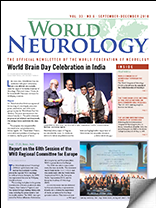London, England, 1935
By Edward H. Reynolds
Following the first International Congress of Neurology in 1931, in Berne, Switzerland, (Koehler 2018), the second congress was held at University College London July 29-Aug. 2, 1935.
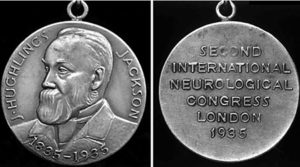
The Hughlings Jackson Centenary Medal for delegates at the congress. Reproduced from Reynolds (2005), with the agreement of the BMJ Publishing Group Ltd.
The president of the congress was Gordon Holmes, a worthy substitute for Sir Charles Sherrington who was unwell. The secretary general was Samuel Alexander Kinnier Wilson. The congress coincided with the centenary of the birth of John Hughlings Jackson (1835), who was honored by a centenary congress medal given to all of the delegates (Reynolds 2005).
I am the proud owner of Kinnier Wilson’s own copy of the medal given to me by his son, James Kinnier Wilson, with whom I have collaborated on Babylonian neurology and psychiatry. Since 2005, two further copies of the medal have come to light, both in the U.S., one of which is now in the Archives of the National Hospital for Neurology and Neurosurgery in Queen Square, London.
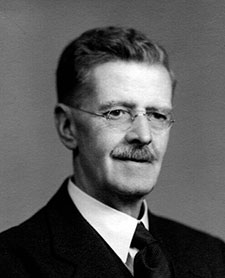
Gordon Holmes (1876-1965), president of the congress. Public domain.
Naturally, the main theme of the congress was the Epilepsies. Three other themes were:
- The physiology and pathology of the cerebrospinal fluid
- The functions of the frontal lobes
- The hypothalamus and central representation of the autonomic nervous system. In addition, about 250 free communications were given by delegates from 20 countries. Interestingly, the official languages of the congress were English, French, German, Italian, and Spanish, but abstracts had to be in one of the first three languages.
The Epilepsies: William Gordon Lennox (Boston) laid to rest the time honored theory that epilepsy was the result of generalized cerebral arterial spasm by demonstrating no change in cerebral blood flow before a convulsion in 10 patients. At the same time, he introduced a new chapter in epilepsy research by applying Berger’s recently discovered human electro-encephalograph (EEG) to 31 patients in whom he showed abnormal electrical changes prior to seizures, which increased during the attacks. Neurosurgeon Wilder Penfield (Montreal) also applied the EEG as well as cortical stimulation to demonstrate the new possibilities for epilepsy surgery in 41 patients with focal cortical atrophy and cicatrix. Jean Abadie (Bordeaux) considered that epilepsy was no longer a disease but a variety of anatamo-clinical syndromes, invariably acquired. Ernest A. Spiegel (Philadelphia) emphasized that the pathogenesis of convulsions must be sought in alterations in ion concentrations across neuronal semi-permeable membranes.
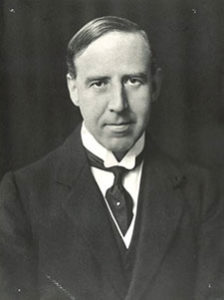
Samuel Alexander Kinnier Wilson (1878-1937), secretary general of the congress. Reproduced with permission of James Kinner Wilson.
- Frisch (Vienna) discussed the role of general metabolism including water, salt, and alkalosis. Kazimierz Orzechowski (Warsaw) continued to view epilepsy as vascular in origin, and Mieczyslaw Minkowski (Zurich) discussed the variable neuropathology of epilepsy. Alfred Ulrich (Zurich) considered the role of bromides in the treatment of epilepsy and the value of measuring bromide levels. Louis J.J. Muskens (Amsterdam) stressed the need for special institutions for treating some patients with severe epilepsy.
The Cerebrospinal Fluid: Lewis H. Weed (Baltimore), Georg Schaltenbrand (Wϋrzburg), and Felix Georgi (Yverdon) all discussed the anatomy, development, and physiology of the choroid plexus and whether the fluid was a secretion, filtrate, or dialysate. Neurosurgeon Hugh Cairns (London) described at least 18 causes of hydrocephalus in infancy and less common causes in adults, including post-operative hydrocephalus following removal of posteria fossa tumours. He also commented on cerebral oedema and shrinkage.
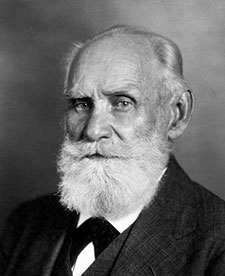
Ivan Pavlov (1848-1936), guest lecturer at the Congress. Public domain.
Functions of the Frontal Lobes: Jean Alexandre Barré (Strasbourg) and Paul Delmas-Marsalet (Bordeaux) both discussed ataxic syndromes associated with frontal lobe lesions and the relative contributions of cerebellar, labyrinthine, apraxic, and agnosic factors. Kurt Goldstein (New York) and neurosurgeon Clovis Vincent (Paris) described variable or no mental and behavioral symptoms with frontal lesions. R.M. Brickner (New York) suggested the main function of the frontal lobes was ingenuity. It was at this congress that neurophysiologist John Fulton and his colleague Carlyle Jacobsen presented the results of frontal lobotomy in two chimpanzees. António Egas Moniz and Walter Freeman met, and this probably influenced the latter’s endeavors with respect to human frontal lobotomy.
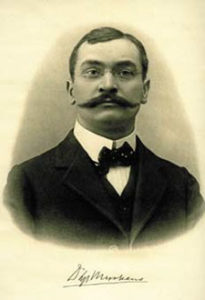
Louis Jacob Joseph Muskens (1872-1937), prime mover and first secretary general of ILAE 1909-1914. Elected vice president during the 1935 Congress revival of ILAE. He wisely proposed an American president because of the catastrophic politics in Europe at that time.
The Hypothalamus and Central Representation of the Autonomic Nervous System: Cornelius U. Ariëns Kappers (Amsterdam) described the phylogenetic development of the autonomic nervous system in amphibia and lower mammals, and Wilfrid E. Le Gros Clark (Oxford) the ontogenetic development in man. Jean Lhermitte (Paris) discussed numerous clinical syndromes and pathologies linked to the hypothalamic, pituitary, and endocrine connections. Alfred W. Adson (Mayo Clinic) promoted the role of sympathectomy in the treatment of Raynaud’s disease, hypertension, and other disorders. Otto Löwenstein (Nyon) demonstrated the role of both physical and psychological influences on the vegetative nervous system, illustrated in particular by the pupillary reflex.
Other Contributions: Among the numerous free communications worthy of note were:
- Several presentations by Egas Moniz and his colleagues from Lisbon on cerebral angiography
- A twin study of heredity in epilepsy by Klaus Conrad (Munich) suggesting 70 percent concordance in uniovular twins and 11.5 prcent concordance in binovular twins.
A special guest lecture was given in German by Ivan P. Pavlov (Leningrad), now in his 87th year, on “the types of higher nervous activity, their relation with the neuroses and psychoses, and the physiological mechanism of neurotic and psychotic symptoms.” Based largely on his studies of conditioned reflexes and personality types in dogs, he speculated on the role of human conditioning, including the enormous impact in man of the spoken, heard, and seen word.
Another guest speaker was neurosurgeon Otfrid Foerster (Breslau) who gave the triennial Hughlings Jackson Lecture, which normally would have been given to the neurology section of the Royal Society of Medicine in London. He spoke on “the motor cortex in man in the light of Hughlings Jacksons doctrines” (see Reynolds 2005).
Social functions included a government reception hosted by the Minister of Health at Lancaster House, receptions at the Royal Colleges of Physicians and Surgeons, and a congress banquet at the Grosvenor Hotel.
Revival of the International League against Epilepsy (ILAE): On July 31, a free day at the congress, 32 delegates from 14 countries visited the Lingfield Epilepsy Colony in Surrey, where they agreed to revive the ILAE. The ILAE had been founded at the 16th International Medical Congress in 1909 in Budapest, but had ceased to function after the outbreak of the first world war, the last issue of Epilepsia, the League’s journal, having been published in 1915. On Aug. 2 in London, Walter G. Lennox (U.S.) was elected president; Louis J.J. Muskens (Netherlands) vice president, Hans Iacob Schou (Denmark) secretary and J. Tylor Fox (Lingfield, U.K.) treasurer. Muskens had been a prime mover and first Secretary General of ILAE from 1909-1914. The ILAE has since evolved into a global professional organization with 120 national chapters in every continent, working closely with the International Bureau for Epilepsy (lay) and the World Health Organisation on a worldwide public health campaign. It celebrated its centenary in Budapest in 2009 and is the oldest international neurological specialty organization (Shorvon et al 2009). •
References
Eling P, Keyser A. Louis Muskens: a leading figure in the history of Dutch and world epileptology. J Hist Neurosci. 2003;12:276-85.
International Neurological Congress. Lancet 1935; 2: 268-9 and 332-6.
Koehler PJ. The first International Congress of Neurology. World Neurology: Newsletter of the World Federation of Neurology. March 6th 2018.
Reynolds EH. The John Hughlings Jackson 1935 Centenary Congress Medal. J Neurol Neurosurg Psychiatry 2005; 76: 858-859.
Shorvon S. Weiss G, Avanzini G, Engel J, Meinardi H, Moshé S, Reynolds E, Wolf P. International League against Epilepsy 1909-2009: A Centenary History. Chichester: Wiley-Blackwell, 2009.
